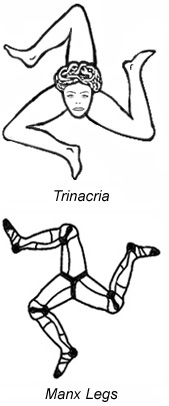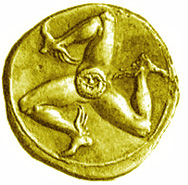...Best of Sicily presents... Best of Sicily Magazine. ... Dedicated to Sicilian art, culture, history, people, places and all things Sicilian. |
by Carlo Trabia | ||
Magazine Index Best of Sicily Arts & Culture Fashion Food & Wine History & Society About Us Travel Faqs Contact Map of Sicily |
As displayed in Sicily, the triskelos, as the Greeks called it, features the head of Medusa at the centre of three conjoined, nude legs. In antiquity the Medusa was a generic gorgon's head. The symbol appeared in the coinage of Greek Sicily. In the Syracusan gold piece shown here the feet are winged like those of Hermes (Mercury). Despite its widespread numismatic use, the trinacria itself never became a heraldic symbol in Sicily. That is to say, it never appeared in a Sicilian coat of arms until very recently. Yet it was published in numerous official documents over the centuries. By 1270, if not long before, a similar symbol became known as the heraldic insignia of the Isle of Man, sometimes simply called Mann. The difference from the Trinacria is that the Manx legs are armoured and accompanied by no other feature. There is no head.
Back in Sicily, the trinacria sometimes appeared on coins. In 1302, with the treaty known as the Peace of Caltabellotta, an agreement sanctioned by the Papacy following decades of strife in the wake of the Vespers War of 1282, King Frederick III "the Simple" of Aragon (father of Queen Mary) was recognized as the ruler of Sicily if he styled himself "King of Trinacria," while his royal counterpart in Naples retained the nominal title "King of Sicily." About the Author: Carlo Trabia is an architect who lectures on architectural history. | |
Top of Page |
 The Trinacria, a form of the triskelion, has been the
symbol of Sicily since the
The Trinacria, a form of the triskelion, has been the
symbol of Sicily since the  It is believed - through an unproved theory - that this symbol was introduced
on Mann during Plantagenet times. The
It is believed - through an unproved theory - that this symbol was introduced
on Mann during Plantagenet times. The